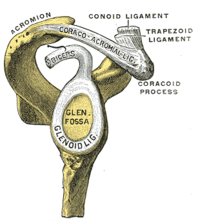
Photo from wikipedia
AbstractObjectivesTo describe characteristics of foetuses undergoing in utero repair of open neural tube defects (ONTD) and assess postoperative evolution of posterior fossa and brain morphology.MethodsAnalysis of pre- and postoperative foetal… Click to show full abstract
AbstractObjectivesTo describe characteristics of foetuses undergoing in utero repair of open neural tube defects (ONTD) and assess postoperative evolution of posterior fossa and brain morphology.MethodsAnalysis of pre- and postoperative foetal as well as neonatal MRI of 27 foetuses who underwent in utero repair of ONTD. Type and level of ONTD, hindbrain configuration, posterior fossa and liquor space dimensions, and detection of associated findings were compared between MRI studies and to age-matched controls.ResultsLevel of bony spinal defect was defined with exactness of ± one vertebral body. Of surgically confirmed 18 myelomeningoceles (MMC) and 9 myeloschisis (MS), 3 MMC were misdiagnosed as MS due to non-visualisation of a flat membrane on MRI. Hindbrain herniation was more severe in MS than MMC (p < 0.001). After repair, hindbrain herniation resolved in 25/27 cases at 4 weeks and liquor spaces increased. While posterior fossa remained small (p < 0.001), its configuration normalised. Lateral ventricle diameter indexed to cerebral width decreased in 48% and increased in 12% of cases, implying a low rate of progressive obstructive hydrocephalus. Neonatally evident subependymal heterotopias were detected in 33% at preoperative and 50% at postoperative foetal MRI.ConclusionMRI demonstrates change of Chiari malformation type II (CM-II) features.Key Points• Hindbrain herniation is significantly more pronounced in myeloschisis than in myelomeningocele • Resolution of hindbrain herniation 4 weeks after in utero closure of ONTD • MRI is valuable for preoperative assessment and postoperative evaluation following in utero repair
Journal Title: European Radiology
Year Published: 2017
Link to full text (if available)
Share on Social Media: Sign Up to like & get
recommendations!